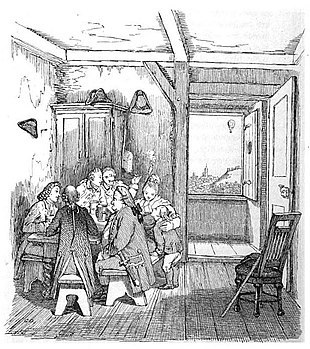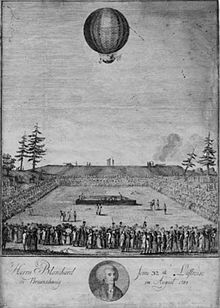The trip to Braunschweig (Knigge)

|

|
|
|
Illustrations by Georg Osterwald (1803–1884) for the seventh edition, 1839
|
||
The trip to Braunschweig. A comischer novel is a humorous novel by the German writer and enlightener Adolph Knigge (1752-1796). The book first appeared in 1792, four years before the author's death.
content
The trip to Braunschweig describes the journey of a group of four people from the fictional town of Biesterberg near Hanover to the city of Braunschweig to experience the balloon ascent of the French balloonist Blanchard .
The action begins on the afternoon of August 6, 1788, when the bailiff Waumann and his 23-year-old son Valentin learned from a newspaper about the upcoming balloon flight, which is to take place four days later, on August 10, in Braunschweig. The forester Dornbusch and the village pastor Schottenius join their intention to travel to this event, who combined this trip with the goal of finding a publisher of his collection of pulpit sermons in Braunschweig.
The tour company set out on August 9th with two carriages and after a night in Hildesheim reached the town of Peina (until the 19th century the name of today's district town Peine in Lower Saxony , about 25 kilometers west of Braunschweig). There the group splits up because there are not enough fresh horses available in the post office to change horses for both carriages. While forester Dornbusch and Pastor Schottenius stay behind in the hope that more horses will arrive, father and son Waumann continue the journey.
Immediately after arriving in Braunschweig, bailiff Waumann received a letter from the pastor by express courier, informing him that those who stayed behind would not come because they had met the forester's "blown" niece in Peina. The young woman had fled again, the forester and the pastor were taking up the pursuit.
But the bailiff and his son fail too. Valentin is stolen from a fraudulent musician and locked in a toilet. Bailiff Waumann missed the balloon ride in front of the city gates of Braunschweig in an inn and only learned from the shouts of the audience: " Se heft en wedder !" ( Low German for: "You have him again!") That the balloonist had already landed successfully.
History of origin
The historical background to the plot is a balloon ride that Jean-Pierre Blanchard (1753–1809) undertook at the gates of the city of Braunschweig. The event took place on Sunday, August 10, 1788, between the Wendentor and the Fallersleber Tor . Today there are buildings of the Technical University of Braunschweig on this site in the Braunschweig Nordstadt .
At this time, Adolph Knigge was also in Braunschweig to visit relatives there, as he mentioned in his biography . It is possible that he also witnessed the spectacular event at the time. It is unlikely, however, that he postponed visiting relatives and that the balloon flight was the actual reason for his stay. Knigge criticized the balloon pioneer's ventures without any sympathy and called them derogatory in his novel " Blanchardsche Hannswursterey ".
Further incidents in the plot also seem not to stem from Knigge's imagination alone. The author had been betrayed by a musician himself while on a trip. Knigge's grandson and publisher Friedrich Wilhelm von Reden (1802-1857) later reported that Knigge was a witness when a Nuremberg merchant, who was traveling with his family to the Braunschweig event, missed the balloon ride because he refreshed himself in a tavern.
Reception and circulation history
Die Reise nach Braunschweig was a well-read novel of the 19th century and the author's most successful narrative work was reprinted in 1793, 1794, 1802, 1803 and in 1839 the work was published in its seventh edition. Today, Adolph Knigge is best known for his work On Dealing with People .
Gotthelf Friedrich Müller († 1814) tried to build on the success of the work , who in 1798 presented a continuation of the travel novel under the pseudonym Lucas Veit .
In the 1880s, the literary scholar Erich Schmidt (1853–1913) described the novel Die Reise nach Braunschweig as Knigge's best-known work. However, he missed the humor in it, criticized the “raw comedy” and the sometimes “quite drastic situations”. The Czech literary historian Paul Reimann (1902–1976) called the work a remarkable representation of German life in the 18th century.
expenditure
German-language editions (selection)
- The trip to Braunschweig . Ritscher, Hanover 1792 [first edition].
- The trip to Braunschweig. 7th edition. published by the author's grandson, with 36 sketches by G. Osterwald , Hahnsche Hofbuchhandlung, Hanover 1839.
- The trip to Braunschweig . Wenderoth, Kassel 1972, ISBN 3-87013-001-6 .
- The trip to Braunschweig. In: Adolph Freiherr Knigge: Works , Volume 4, Paul Raabe (Ed.), Wallstein, Göttingen 2010, ISBN 978-3-8353-0410-9 .
Translations (selection)
- The journey to Brunswijk . Haarlem 1793 [Dutch].
- Resan til Brunswig . Stockholm 1795 [Swedish.]
- Le voyage à Brunswick . Paris 1797 [French].
- Le voyage à Brunswick . Saint-Étienne 1992, ISBN 2-902301-22-7 [French].
literature
Bibliographies
- Ernst August Knigge (Ed.): Knigges works: a bibliography of printed writings, compositions and letters . Wallstein Verlag, Göttingen 1996, ISBN 3-89244-229-0 .
Overviews
- Otto F. Best : [Work article] The trip to Braunschweig. In: Heinz Ludwig Arnold (Hrsg.): Kindlers Literatur Lexikon . 3rd, completely revised edition. 18. Vol., Metzler, Stuttgart / Weimar 2009, ISBN 978-3-476-04000-8 , Vol. 9, p. 187.
Studies
- Michael Schlott (Ed.): Effects and evaluations: Adolph Freiherr Knigge in the judgment of posterity (1796–1994) . Wallstein, Göttingen 1998, ISBN 3-89244-287-8 .
- Paul Raabe : ... returned to my fatherland: Adolph Freiherr Knigge in Hanover 1787–1790 . Wallstein, Göttingen 2002, ISBN 3-89244-639-3 .
- Masayasu Iwai: Knigges “satirical journeys” in the context of the satirical travel literature of the late Enlightenment . Röhrig, St. Inbert 2007, ISBN 978-3-86110-433-9 , pp. 43-72.
Web links
- Adolph Freiherr Knigge: The trip to Braunschweig; a comic novel in the Gutenberg-DE project
Individual evidence
- ↑ EFJ Koch: History of the dynasty, the office, the city, castle and fortress Peina in Lower Saxony. Hermann Heuer, Peina 1850.
- ↑ Raabe, pp. 69-71.
- ↑ a b c Schlott, pp. 301-311.
- ↑ Heinrich Kurz : History of German literature . Vol. 3, Teubner, Leipzig 1859, p. 507.
- ^ Adolf Freiherr Knigge: The trip to Braunschweig. 7th edition. Hahnsche Hofbuchhandlung, Hanover 1839.
- ↑ Lucas Veit: Journey of the bailiff Waumann, the forester Dornbusch and Ehrn Schottenii from Biesterberg to *** to the fatherhood . Heinrich Georg Albrecht, Wolfenbüttel 1798.
- ↑ Erich Schmidt : Knigge, Adolf . In: Allgemeine Deutsche Biographie (ADB). Volume 16, Duncker & Humblot, Leipzig 1882, pp. 288-291.
- ^ Paul Reimann : Main currents of German literature, 1750-1848 . Dietz, Berlin 1956, p. 302.
